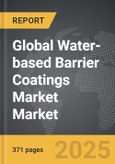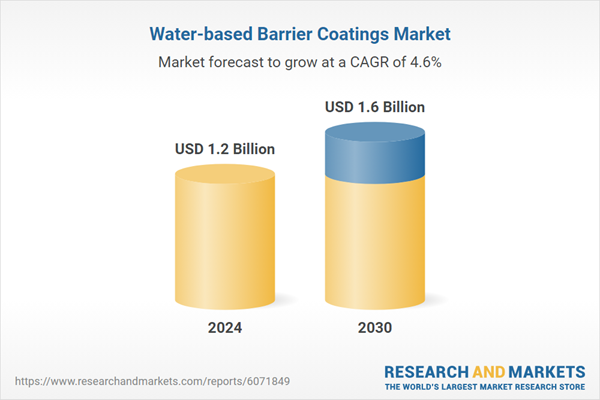Global Water-Based Barrier Coatings Market - Key Trends & Drivers Summarized
Why Are Water-Based Barrier Coatings Gaining Popularity Across Industries?
The demand for water-based barrier coatings has surged across multiple industries due to the growing need for sustainable, high-performance protective solutions that minimize environmental impact. These coatings are primarily used in packaging, automotive, construction, and consumer goods sectors, offering a protective barrier against moisture, grease, oxygen, and other contaminants while eliminating the need for solvent-based formulations that release volatile organic compounds (VOCs). In the packaging industry, particularly for food and beverage applications, water-based barrier coatings provide an eco-friendly alternative to traditional plastic laminates and wax coatings, making paper-based packaging recyclable and compostable. The rapid shift towards sustainable materials in response to stringent environmental regulations and corporate sustainability commitments has further propelled the adoption of these coatings. Additionally, advancements in polymer technology and nanocoatings have enhanced the functionality of water-based barriers, enabling superior resistance to grease, water vapor, and oxygen transmission while maintaining the substrate's recyclability. As industries transition toward circular economy models, water-based barrier coatings are becoming a preferred choice for manufacturers seeking both performance and sustainability.How Are Innovations in Polymer Chemistry and Nanotechnology Enhancing Water-Based Barrier Coatings?
Significant advancements in polymer chemistry and nanotechnology have transformed the capabilities of water-based barrier coatings, allowing them to compete with conventional solvent-based coatings in terms of performance and durability. The development of bio-based polymers and hybrid emulsions has enabled coatings with improved adhesion, flexibility, and barrier properties, making them suitable for demanding applications such as food packaging, medical disposables, and industrial protective coatings. Nanotechnology has played a crucial role in enhancing water-based barriers, with nano-scale additives providing superior resistance to water absorption, oil penetration, and UV degradation. Additionally, the introduction of multilayer barrier coatings incorporating biodegradable and renewable materials has expanded the scope of applications in sustainable packaging. Smart coatings, which respond to environmental changes such as humidity or temperature fluctuations, have also gained traction, improving the longevity and efficiency of coatings in dynamic environments. These innovations are driving the widespread adoption of water-based barrier coatings as industries seek cost-effective and high-performance alternatives to traditional protective coatings.What Challenges Are Impacting the Widespread Adoption of Water-Based Barrier Coatings?
Despite their many advantages, the adoption of water-based barrier coatings faces several challenges related to performance optimization, cost considerations, and regulatory compliance. One of the primary concerns is achieving the same level of moisture and grease resistance as conventional plastic-based or wax coatings, particularly in high-barrier applications such as frozen food packaging and industrial containers. Manufacturers must continuously refine formulations to improve coating integrity while maintaining recyclability and compostability. Additionally, water-based coatings often require longer drying times compared to solvent-based alternatives, which can impact production efficiency and increase energy consumption in high-speed manufacturing environments. The cost of high-performance water-based coatings, especially those incorporating advanced bio-based materials or nanocoatings, remains a challenge for price-sensitive markets. Furthermore, compliance with food safety and environmental regulations varies across regions, requiring manufacturers to tailor formulations to meet different industry standards, adding complexity to product development and commercialization. Addressing these challenges requires ongoing research in coating technologies, improvements in production scalability, and collaborative efforts between manufacturers and regulatory bodies to establish industry-wide standards for sustainable barrier coatings.What Factors Are Driving the Growth of the Water-Based Barrier Coatings Market?
The growth in the water-based barrier coatings market is driven by several factors, including increasing consumer preference for sustainable packaging, advancements in bio-based materials, and regulatory pressures to reduce plastic waste and VOC emissions. The shift towards eco-friendly packaging solutions in food and beverage, cosmetics, and e-commerce sectors has significantly boosted demand for recyclable and compostable barrier coatings. Governments worldwide are implementing stricter environmental policies that encourage the adoption of water-based formulations, compelling industries to phase out solvent-based coatings in favor of sustainable alternatives. The expansion of the e-commerce and logistics industry has also fueled the need for durable, moisture-resistant protective coatings that enhance packaging integrity during transit. Additionally, the rise of smart packaging and intelligent coatings has created new growth opportunities, with manufacturers developing water-based coatings that offer antimicrobial properties, oxygen scavenging, and enhanced shelf-life protection. As research and innovation continue to drive material performance and production efficiency, the market for water-based barrier coatings is expected to witness sustained growth, reshaping the future of protective coatings in industrial and consumer applications.Report Scope
The report analyzes the Water-based Barrier Coatings market, presented in terms of market value (US$). The analysis covers the key segments and geographic regions outlined below:- Segments: Barrier Type (Water Vapor Barrier, Oil / Grease Barrier, Other Barrier Types); Substrate (Paper & Cardboard, Other Substrates); End-Use (Food & Beverage Packaging, Other End-Uses).
- Geographic Regions/Countries: World; United States; Canada; Japan; China; Europe (France; Germany; Italy; United Kingdom; Spain; Russia; and Rest of Europe); Asia-Pacific (Australia; India; South Korea; and Rest of Asia-Pacific); Latin America (Argentina; Brazil; Mexico; and Rest of Latin America); Middle East (Iran; Israel; Saudi Arabia; United Arab Emirates; and Rest of Middle East); and Africa.
Some of the 44 companies featured in this Water-based Barrier Coatings market report include -
- AkzoNobel N.V.
- Altana Group
- Amcor
- Arkema Group
- Asian Paints
- Avery Dennison
- BASF SE
- Cattie Adhesives
- Chenyang Waterborne Paint
- Dow Inc
- H.B. Fuller Company
- Henkel AG & Co. KGaA
- Imerys
- Jotun
- Kansai Paint Co., Ltd
- Kuraray Co., Ltd
- Michelman, Inc
- Nippon Paint Company Limited
- Omya AG
- PPG Industries, Inc.
Key Insights:
- Market Growth: Understand the significant growth trajectory of the Water Vapor Barrier Coatings segment, which is expected to reach US$896 Million by 2030 with a CAGR of a 3.7%. The Oil / Grease Barrier Coatings segment is also set to grow at 6% CAGR over the analysis period.
- Regional Analysis: Gain insights into the U.S. market, valued at $337.2 Million in 2024, and China, forecasted to grow at an impressive 7.2% CAGR to reach $315.6 Million by 2030. Discover growth trends in other key regions, including Japan, Canada, Germany, and the Asia-Pacific.
Why You Should Buy This Report:
- Detailed Market Analysis: Access a thorough analysis of the Global Water-based Barrier Coatings Market, covering all major geographic regions and market segments.
- Competitive Insights: Get an overview of the competitive landscape, including the market presence of major players across different geographies.
- Future Trends and Drivers: Understand the key trends and drivers shaping the future of the Global Water-based Barrier Coatings Market.
- Actionable Insights: Benefit from actionable insights that can help you identify new revenue opportunities and make strategic business decisions.
Key Questions Answered:
- How is the Global Water-based Barrier Coatings Market expected to evolve by 2030?
- What are the main drivers and restraints affecting the market?
- Which market segments will grow the most over the forecast period?
- How will market shares for different regions and segments change by 2030?
- Who are the leading players in the market, and what are their prospects?
Report Features:
- Comprehensive Market Data: Independent analysis of annual sales and market forecasts in US$ Million from 2024 to 2030.
- In-Depth Regional Analysis: Detailed insights into key markets, including the U.S., China, Japan, Canada, Europe, Asia-Pacific, Latin America, Middle East, and Africa.
- Company Profiles: Coverage of players such as ABB Ltd., Agilent Technologies, Inc., Badger Meter, Inc., DH Life Sciences, LLC, Emerson Electric Co. and more.
- Complimentary Updates: Receive free report updates for one year to keep you informed of the latest market developments.
Select Competitors (Total 44 Featured):
- AkzoNobel N.V.
- Altana Group
- Amcor
- Arkema Group
- Asian Paints
- Avery Dennison
- BASF SE
- Cattie Adhesives
- Chenyang Waterborne Paint
- Dow Inc
- H.B. Fuller Company
- Henkel AG & Co. KGaA
- Imerys
- Jotun
- Kansai Paint Co., Ltd
- Kuraray Co., Ltd
- Michelman, Inc
- Nippon Paint Company Limited
- Omya AG
- PPG Industries, Inc.
This edition integrates the latest global trade and economic shifts into comprehensive market analysis. Key updates include:
- Tariff and Trade Impact: Insights into global tariff negotiations across 180+ countries, with analysis of supply chain turbulence, sourcing disruptions, and geographic realignment. Special focus on 2025 as a pivotal year for trade tensions, including updated perspectives on the Trump-era tariffs.
- Adjusted Forecasts and Analytics: Revised global and regional market forecasts through 2030, incorporating tariff effects, economic uncertainty, and structural changes in globalization. Includes historical analysis from 2015 to 2023.
- Strategic Market Dynamics: Evaluation of revised market prospects, regional outlooks, and key economic indicators such as population and urbanization trends.
- Innovation & Technology Trends: Latest developments in product and process innovation, emerging technologies, and key industry drivers shaping the competitive landscape.
- Competitive Intelligence: Updated global market share estimates for 2025, competitive positioning of major players (Strong/Active/Niche/Trivial), and refined focus on leading global brands and core players.
- Expert Insight & Commentary: Strategic analysis from economists, trade experts, and domain specialists to contextualize market shifts and identify emerging opportunities.
Table of Contents
Companies Mentioned (Partial List)
A selection of companies mentioned in this report includes, but is not limited to:
- AkzoNobel N.V.
- Altana Group
- Amcor
- Arkema Group
- Asian Paints
- Avery Dennison
- BASF SE
- Cattie Adhesives
- Chenyang Waterborne Paint
- Dow Inc
- H.B. Fuller Company
- Henkel AG & Co. KGaA
- Imerys
- Jotun
- Kansai Paint Co., Ltd
- Kuraray Co., Ltd
- Michelman, Inc
- Nippon Paint Company Limited
- Omya AG
- PPG Industries, Inc.
Table Information
| Report Attribute | Details |
|---|---|
| No. of Pages | 371 |
| Published | December 2025 |
| Forecast Period | 2024 - 2030 |
| Estimated Market Value ( USD | $ 1.2 Billion |
| Forecasted Market Value ( USD | $ 1.6 Billion |
| Compound Annual Growth Rate | 4.6% |
| Regions Covered | Global |









